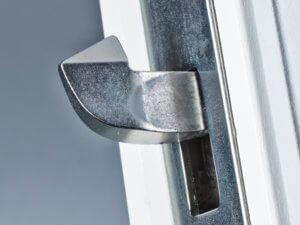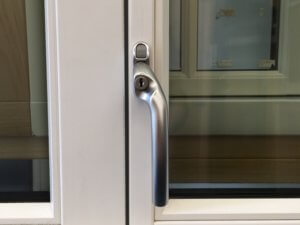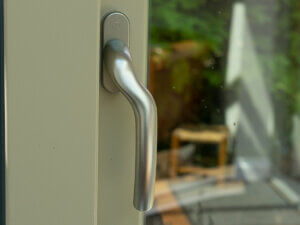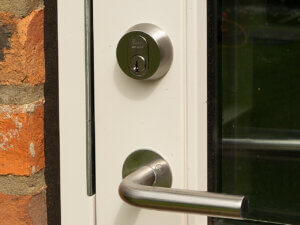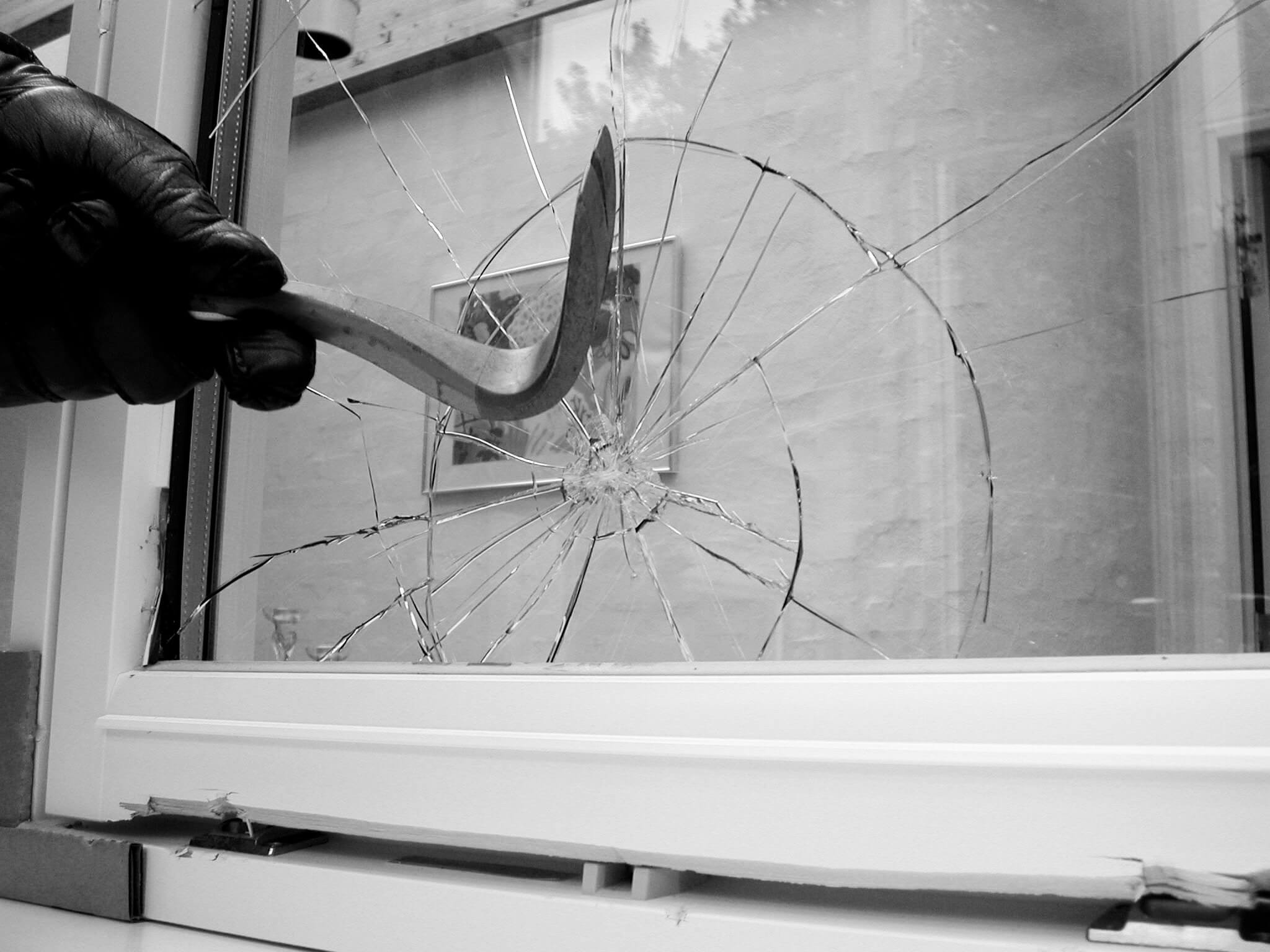The security of your new windows and doors is probably one of, if not the most, important area to be certain of. There are a number if different ways and certifications to allow a window to prove it will be secure. Interesting, in the UK, a security certification is only required for windows going into brand new homes, but we think (for hopefully obvious reasons) that it’s important to ascertain the security properties of the product you’re looking to buy if you’re renovating too.
Multipoint Locks
Probably the most important aspect for secure windows that is a standard item on higher-quality options. A multipoint lock in either a window or a door means that turning a single handle or key results in locking points engaging throughout the frame. The mechanism inside that allows this to happen is called the espagnolette. Normally, you can expect a window to have 2-3 locking points, and a door would have 3-5.
Both receiver plates and screws are normally reinforced. Hardened steel bolts are the norm and some companies include bolts on the hinge side of a door too. This is so that the door remains locked closed even if a hinge is forcefully removed.
Key-Locking Window Handles
This is oddly an area for debate, because the answer is not necessarily so simple as “lockable = more secure window”.
When you turn the key in any window handle, it doesn’t engage any extra pins or bolts. It purely prevents the handle from being turned, because turning the handle itself is what engages all of the locking points in the window. If an attacker is standing on the outside trying to break in, it’s arguably not much easier for them to gain entry if the handle doesn’t lock. Combine this with the fact that most people leave their window handles unlocked anyway, and that breaking at least two 4mm panes of glass to reach a handle would almost certainly awaken you and your neighbour, we think the answer is not so straight forward on secure windows.
Obviously, there is a peace-of-mind aspect of you, your family and any guests knowing that windows are locked – which should not be ignored – and many house insurance companies favour having key-locking window handles.
We find that our customer’s opinions are very split on the subject, and it is very much a question of preference and circumstance.
For more information about the handle options available, check out our Danish Window and Door Handles blog
Door Locks and Cylinders
Turning a key in a door lock is very different to turning a key in a window. On a multipoint lock, bolts are engaged at top, middle and bottom of the frame, and the handle will be locked in place. The locking cylinder in a door is therefore very important for door security, so we recommend making sure the product you’re buying comes with a lock from a reputable source.
Our most popular solution is the Ruko Scandinavian oval lock. This is a 6-pin lock that checks 2 different height positions as you turn the key, and a code must be supplied when copying the key to prevent key-cloning. Our attention was sharply drawn towards this lock following a call from a professional UK locksmith had failed to unlock a customer’s home when their son become locked outside. After explaining, a replacement key was quickly sourced from a certified Ruko key-cutter after the customer supplied them with their code.
Keypads, Fingerprint Scanners and other “Smart” Locks
Electronic are either set up as a double lock, requiring both electronic identification and a key, or they are set up as a single lock with an override.
Double-locking is the equivalent of multifactor authentication: requiring you to have the key and know the code (much like needing your credit card and a pin). So, this gives extra security. The only downside is it now takes longer to open your door than it otherwise would.
Single locking is the inverse of this: it could be argued that you lose security… You’re now open to code bugs or someone simply copying a keycard or code and therefore being able to open your door without a physical key.
Honestly, keys are still a great option, and will cost a lot less than an electronic lock. Most people have no idea how to pick a key-lock, even fewer people will know how to do it subtly whilst visible from a nearby street and (specifically for our locks) even fewer people in the UK are used to dealing with Scandinavian ovals.
Toughened and Laminated Glass
Safety glass comes in two forms: toughened or laminated. Most manufacturers offer both options, and they have a very different structure.
Toughened Glass
By rapidly heating and cooling the glass in the tempering process, a toughened pane of glass becomes five times stronger than a standard pane of the same thickness.
Laminated Glass
This is actually two panes of glass sandwiched together with a lamination layer in between – resulting in a much thicker pane. If the glass is smashed, the lamination layer holds all the panes together. A by-product of this method of manufacture is an acoustic barrier – laminated glass is great for both security and sound insulation.
Since both solutions provide different types of protection (not necessarily better or worse), when secure windows are needed, our normal approach is to include one toughened pane and one laminated pane in the same glass unit. Our logic here is that an attacker may have the tools to break through one type of glass pane, but they will be stuck trying to use the same tool on the other pane.
Specific Tests and Certifications
Since almost all our products are manufactured by Danish companies, we must talk about UK and European certifications – as we have some UK-specific certificates this side of the channel.
Starting with the easy part, the whole of Europe acknowledges four tests to be acceptable for newbuild secure windows: EN1627-30 is referenced by most European products, and these tests are a requirement if a Danish factory wishes to be DVV-certified (a well-known quality-guarantee certification in Denmark).
The UK regulations are a little more complex. For a window to be secure according to UK building regulations, it must be compliant with Part Q. Among other things, it must have a certification equivalent or better than PAS24 (EN1627-30 is often accepted). A UK home can sometimes require Secure-By-Design, then it must also have SBD approval in addition to the items outlined in Part Q.
For replacement windows, none of this is officially required. For newbuilds, if you’re unsure, it’s very much worth asking your local building control to approve the certification that your preferred product has before you order.
Your Next Steps
If it isn’t clearly displayed on your quotation or the product brochure, do make sure to query with your supplier what they’re providing for you security-wise. A lot of companies will be offering their best possible secure windows and doors as standard, but we’ve come across a few who still offer cylinder upgrades. Especially if you’re looking for windows to a newbuild, the window suppliers you’re speaking to should be well-versed in security requirements and should be able to tell you exactly how their window meets them.
Contact us!
For any questions about our products and services, or to get your quote,
please get in touch by phone, email, or using our in-browser contact form!
Leamington: 01926 935 607
London: 0203 633 0476
E-mail : sales@enlightenedwindows.co.uk
Contact Form: Contact Us

